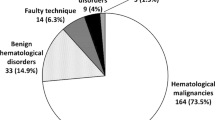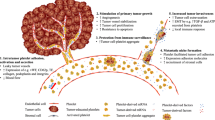Abstract
Paravertebral block is a method of regional block used to make pain relief and decrease systemic analgesic requirements for patients undergoing breast cancer surgery. This work aimed to evaluate the effect of paravertebral block on monocyte phenotype and their functions after surgery for cancer breast patients. One hundred patients which the American Society of Anesthesia (ASA) I–III planned for breast cancer surgery were allocated into two groups. Group A (n = 50) received general anesthesia in a standard technique. Group B (n = 50) received paravertebral block T2–T6 20 ml plain bupivacaine 0.5 % plus 10 ml 2 % lidocaine prior to induction of general anesthesia. Two samples were collected from all patients preoperatively as a baseline and 24 h after surgery. Flow cytometric monocyte phenotype analysis (CD14, HLA-DR, and CD86) was performed. In addition, tumor necrosis factor alpha (TNF-α), monocyte inhibitory factor (MIF), and macrophage chemoattractant protein (MCP-1) were measured in both groups. There were no significant differences between the two groups as regard to age, weight, height, and duration of surgery. One day after surgery, there was significant decrease in all measured markers (CD14, HLA-DR, and CD86) in group A. On the other hand, insignificant decrease in CD 14 and HLA-DR and insignificant increase in CD86 in group B were observed, also 24 h after surgery. As regard to monocyte producing cytokines, significant increase in TNF-α and MIF levels was recorded in both groups after 24 h of surgery; these increases were the same in TNF-α level and more significant in MIF in group A than group B. MCP-1 was decreased insignificantly in group A and significantly in group B. Paravertebral block combined with general anesthesia can significantly reduce monocyte suppression which is an integral part of immunological response following major surgery.
Similar content being viewed by others
References
Ahlers O, Nachtigall I, Lenze J et al (2008) Intraoperative thoracic epidural anesthesia attenuates stress-induced immunosuppression in patients undergoing major abdominal surgery. Br J Anaesth 101(6):781–787
Ayala A, Perrin MM, Chaudry IH (1990) Defective macrophage antigen presentation following haemorrhage is associated with the loss of MHC class II (Ia) antigens. Immunology 70:33–39
Belge KU, Dayyani F, Horelt A et al (2002) The proinflammatory CD14_CD16_DR__ monocytes are a major source of TNF. J Immunol 168:3536–3542
Bucala R, Donnelly SC (2007) Macrophage migration inhibitory factor: a probable link between inflammation and cancer. Immunity 26:281–285
Calandra T, Roger T (2003) Macrophage migration inhibitory factor: a regulator of innate immunity. Nat Rev Immunol 3:791–800
Cheadle WG, Hershman MJ, Wellhausen SR, Polk HC Jr (1991) HLA-DR antigen expression on peripheral blood monocytes correlates with surgical infection. Am J Surg 161:639–645
Conrick-Martin I, Kell MR, Buggy DJ (2012) Meta-analysis of the effect of central neuraxial regional anesthesia compared with general anesthesia on postoperative natural killer T lymphocyte function. J Clin Anesth 24:3–7
Exadaktylos AK, Buggy DJ, Moriarty DC et al (2006) Can anesthetic technique for primary breast cancer surgery affect recurrence or metastasis? Anesthesiology 105:660–664
Fingerle G, Pforte A, Passlick B et al (1993) The novel subset of CD14þ/CD16þ blood monocytes is expanded in sepsis patients. Blood 82:3170–3176
Fingerle-Rowson G, Angstwurm M, Andreesen R, Ziegler-Heitbrock HWL (1998) Selective depletion of CD14: þ/CD16þ monocytes by glucocorticoid therapy. Clin Exp Immunol 112:501–506
Grage-Griebenow E, Flad HD, Ernst M (2001) Heterogeneity of human peripheral blood monocyte subsets. J Leukoc Biol 69(1):11–20
Jedynak OS (2004) Serum concentrations of MCP-1 and RANTES in patients during aortic surgery: the relationship with ischemia-reperfusion. Arch Immunol Ther Exp 52:201–207
Kappelmayer J, Bernabei A, Gikakis N et al (1993) Up-regulation of Mac-1 surface expression on neutrophils during simulated extracorporeal circulation. J Lab Clin Med 121:118–126
Karin M, Lawrence T, Nizet V (2006) Innate immunity gone awry: linking microbial infections to chronic inflammation and cancer. Cell 124:823–835
Locher C, Vanham G, Kestens L et al (1994) Expression patterns of Fcg receptors, HLADR and selected adhesion molecules on monocytes from normal and HIV-infected individuals. Clin Exp Immunol 98:115–122
Moselli NM, Baricocchi E, Ribero D et al (2011) Intraoperative epidural analgesia prevents the early proinflammatory response to surgical trauma. Results from a prospective randomized clinical trial of intraoperative epidural versus general analgesia. Ann Surg Oncol 18:2722–2731
Nockher WA, Scherberich JE (1998) Expanded CD14þCD16þ monocyte subpopulation in patients with acute and chronic infections undergoing hemoldialysis. Infect Immun 66:2782–2790
Rosseau S, Selhorst J, Wiechmann K et al (2000) Monocyte migration through the alveolar epithelial barrier: adhesion molecule mechanisms and impact of chemokines. J Immunol 164:427–435
Vanham G, Edmonds K, Qing L (1996) Generalized immune reaction in pulmonary tuberculosis: co-activation with HIV infection. Clin Exp Immunol 103:30–34
Williams MA, Rhoades CJ, Newland AC, Kelsey SM (1999) The potential for monocyte-mediated immunotherapy during infection and malignancy. Leuk Lymphoma 34:207–230
Ziegler-Heitbrock HW (1996) Heterogeneity of human blood monocytes: the CD14_ CD16_ subpopulation. Immunol Today 17:424–428
Author information
Authors and Affiliations
Corresponding author
Rights and permissions
About this article
Cite this article
Bakry, R., Sayed, D., Sayed, S. et al. The immunological role of monocytes and their cytokines in patients with breast cancer undergoing paravertebral analgesia. Comp Clin Pathol 24, 1573–1577 (2015). https://doi.org/10.1007/s00580-015-2118-8
Received:
Accepted:
Published:
Issue Date:
DOI: https://doi.org/10.1007/s00580-015-2118-8




